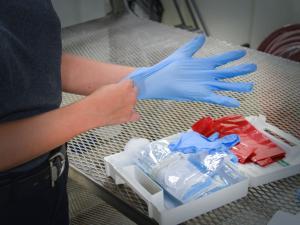3 Things All Employees Should Know About Bloodborne Pathogens

If you’ve watched any sporting event recently, it’s hard not to have noticed the precautions officials take when caring for an injured player who is bleeding. The scene almost always includes a responder or trainer wearing gloves and masks to prevent exposure to bloodborne pathogens.
Sports and medical settings are more commonly associated with possible transmission of bloodborne pathogens. However, exposure to bloodborne viruses like HIV and hepatitis can happen anywhere, especially on the manufacturing floor.
Employees are at risk in any work environment where there’s a chance of an injury that results in bleeding. The National Institutes of Health estimates approximately 3 million exposures to bloodborne pathogens occur annually.
OSHA requires companies to protect employees against bloodborne pathogens, including maintaining a safe work environment. It requires the use of personal protection equipment (PPE) when necessary and training that explains the dangers of bloodborne pathogens and ways to prevent and respond to exposure. OSHA specifies that “employers must offer this training on initial assignment, at least annually thereafter, and when new or modified tasks or procedures affect a worker’s occupational exposure.”
The Alchemy Training System offers a comprehensive workplace safety training program that includes a Bloodborne Pathogens course to help your facility meet OSHA requirements and protect your workforce, including three topics all employees should know.
1. Understand the Risks and How Exposures Occur
Bloodborne pathogens are harmful microorganisms in human blood that can spread through contact with contaminated blood and body fluids. Exposure can lead to the risk of infections for HIV and Hepatitis B and C.
A person with hepatitis may experience mild flu-like symptoms such as fatigue and loss of appetite but may not show any symptoms for up to nine months.
Employees might think their chances of exposure are less because they don’t work in medical or emergency rescue services. However, accidents that cause bleeding can happen in any workplace. That’s why everyone must know how to protect themselves from bloodborne pathogens.
In manufacturing or processing areas, the most common way to be exposed to a bloodborne pathogen is if your blood comes into direct contact with infected blood or an infected object, such as a knife or tool with someone else’s blood on it.
An employee who helps an injured co-worker could easily be exposed, especially if they’re not wearing protective clothing. Depending on the situation, it can be good for a person with a minor cut to apply first aid treatment on their own.
An open cut or sore on exposed skin, such as an employee’s face, hand, or arm, would make bloodborne transmission possible. Their eyes, nose, and mouth are potential transmission spots rarely covered by clothing.

2. Know What to Do if Exposed
Employees should know what to do if exposed to a bloodborne pathogen. For example, if they get blood on their skin, they should immediately wash the area with warm water and a disinfectant soap. After washing, they should use a hand sanitizer on the affected area.
If their eyes are exposed, they should wash them with water or a saline solution immediately and flush the exposed area for at least 20 minutes.
They should immediately tell their supervisor and receive medical treatment as soon as possible. A healthcare professional should know if the employee gets another person’s blood in your eyes, nose, mouth, or other body openings or if it touches a cut or sore on your skin.
As an employer, you should collect as much information about the report and arrange for the employee to see a licensed healthcare professional.
3. Practice Universal Precautions
One of the best ways for employees to protect themselves from bloodborne pathogens is to practice universal precautions that require all blood and body fluids to be treated as if they are contaminated, regardless of the situation.
PPE is also encouraged to add a layer of protection between employees and any pathogens they may find at work. Gloves protect their hands and should be available in any workplace first-aid kit. And remember that disposable gloves should only be used once. Other potential protection layers include goggles, aprons, surgical masks, and face shields.
Once used, all PPE should always be carefully removed to avoid touching the outside of the PPE and placed in the appropriate decontamination area in your workplace to prevent it from contaminating anything or anyone.
Contact us if you have questions about the threat of bloodborne pathogens in your workplace and need help developing a plan to educate and protect your employees.





